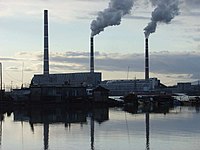
Photo from wikipedia
This study investigates the environmental Kuznets curve (EKC) hypothesis for Brazil, Russia, India, China and South Africa (BRICS) over the period 1990–2014, while considering agricultural activities, energy use, trade openness… Click to show full abstract
This study investigates the environmental Kuznets curve (EKC) hypothesis for Brazil, Russia, India, China and South Africa (BRICS) over the period 1990–2014, while considering agricultural activities, energy use, trade openness and mobile use as driving forces of environmental degradation. The empirical results verify an inverted U-shaped connection between carbon emissions and economic growth. This study confirms the unfriendly impact of agriculture on the environment. Electricity consumption and trade openness likewise exhibit similar impacts on carbon emissions. Mobile use however reduces pollution. A unique revelation from this study is that the interaction between electricity consumption and agricultural activities has an additional pernicious effect on the environment. The methodologies applied for testing the impact of selected independent variables on carbon emissions in BRICS are the Dynamic Ordinary Least Squares (DOLS) and the Fully Modify Ordinary Least Square (FMOLS) for long run regression. Empirical evidence confirms that agriculture exerts a negative impact on the environment in BRICS countries. This study therefore recommends the adoption of cleaner energy processes and enabling high-tech and clean foreign investment.
Journal Title: Environmental Science and Pollution Research
Year Published: 2019
Link to full text (if available)
Share on Social Media: Sign Up to like & get
recommendations!